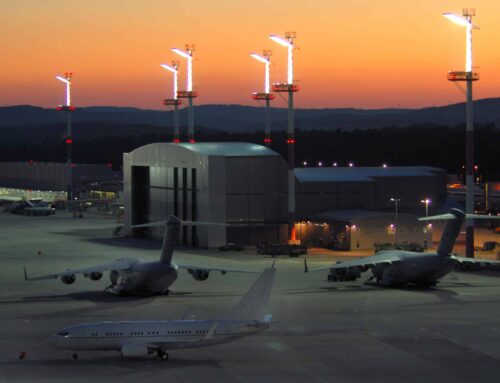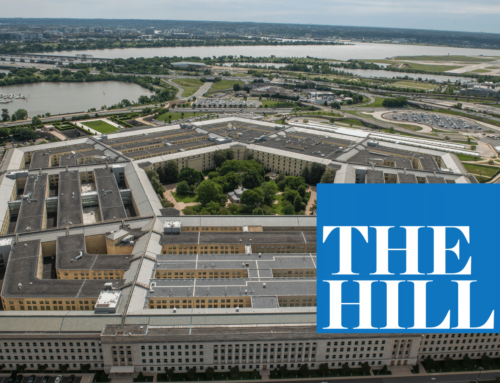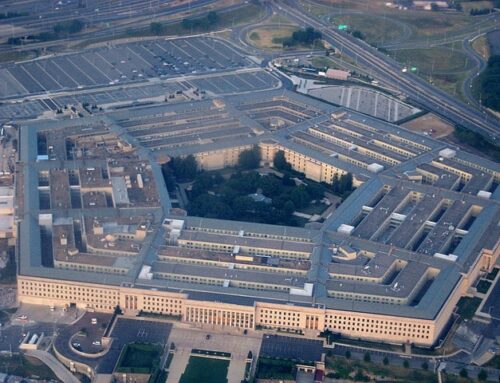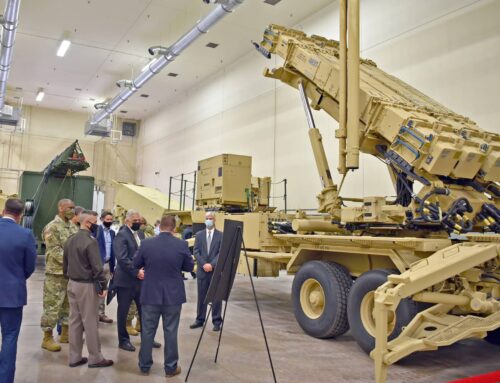The National Defense Authorization Act (NDAA) caps national security spending at $895 billion in 2025, but changes to the Pentagon’s budget request may not hold as the budget process moves forward. TCS policy analyst Gabe Murphy joins host Steve Ellis with an analysis of the potential for Congress to exceed these caps, the Navy’s shipbuilding budget and the F-35.
Transcript
Announcer:
Welcome to Budget Watchdog All Federal, the podcast dedicated to making sense of the budget spending and tax issues facing the nation. Cut through the partisan rhetoric and talking points for the facts about what’s being talked about, bandied about and pushed to Washington, brought to you by taxpayers for common sense. And now the host of Budget Watchdog AF TCS President Steve Ellis.
Steve Ellis:
Welcome to All American Taxpayers Seeking Common Sense. You’ve made it to the right place for nearly 30 years. TCS that’s taxpayers for common sense, has served as an independent nonpartisan budget watchdog group based in Washington dc We believe in fiscal policy for America that is based on facts. We believe in transparency and accountability because no matter where you are on the political spectrum, no one wants to see their tax dollars wasted. Having said that, dear listeners, this week we got our first look at what Congress is thinking of the Pentagon’s budget request for fiscal year 2025 on Monday, the house released based text for the National Defense Authorization Act, or NDAA, the bill that authorizes spending for the Pentagon and lets Congress weigh in on national security policy. The bill adheres to budget caps agreed to last year by capping, could you hear those air quotes, capping national security spending at a whopping $895 billion.
But it also makes changes to the Pentagon’s budget request that may or may not hold. As the budget process moves forward, will Congress have the fiscal discipline to stick to that cap? And what about the process looks different given that it’s an election year? I just want to remind our listeners that one of the things that Congress has been proud of is that an NDAA has been enacted every single year since they first started doing them in the late 1940s. So this is one of the few things that is almost a lock to get done no matter what happens in Congress, whatever happens in the election, it may not be until December 31st, but it’s virtually a lock that this bill will get enacted. So joining me now to explore these questions and detail the specific choices on the table is TCS policy analyst Gabe Murphy. Gabe, welcome back to the podcast.
Gabe Murphy:
Thanks for having me on, Steve.
Steve Ellis:
Alright, Gabe, let’s dig right in. You’ve been pouring over the NDAA so you can help us understand what Congress is up to. Budget Watchdog AF Faithful know that the budget caps agreed to last year CAP spending at 1% above the previous year. We also know that Congress never stuck to the CAPS during the 10 year span of the Budget Control Act that ended a few years ago. Does this first stab at the NDAA mean congress is going to stick to these caps?
Gabe Murphy:
Well, no, Steve, it doesn’t. Unfortunately, a lot of prominent lawmakers have been openly bashing the budget request for the very fact that it adheres to CAPS negotiated last summer between President Biden and then house speaker Kevin McCarthy to name a couple Democrat. John Tester of Montana. He’s the chair of the Senate Appropriation Subcommittee on Defense, observed that he wasn’t sure if the caps would hold and Republican Roger Wicker of Mississippi, the ranking member of the Senate Armed Services Committee, which has jurisdiction over the NDAA said that the budget is blind to the new Cold War. And as far as the house, when the house released its base text of the NDAA, the House Armed Services chair, Mike Rogers, a republican of Alabama said the bill only adhered to the cap. For now to demonstrate how supposedly underfunded the Pentagon is
Steve Ellis:
Not a good sign. Did anybody defend the cap?
Gabe Murphy:
Well, the only cooler head I’ve seen, and there may be others, is representative Adam Smith of Washington, a Democrat serving as the ranking member of the House Armed Services Committee. He said he’s not going down the path of, oh my God, we don’t have enough money, we’re all going to die. And that roughly 900 billion is enough to work with.
Steve Ellis:
Yeah, it may have been 15 years ago. But then defense Secretary Gates, who served under both President Bush and President Obama observed that if they couldn’t defend the country on half a trillion dollars, then their problems couldn’t be fixed with more ships or planes. So obviously that’s almost double what he was talking about only 15 years ago and that really still holds. So hopefully Congressman Smith can bring some of his colleagues around to his way of thinking, looking beyond the cap, even though the NDAA sticks for now, Congress didn’t just rubber stamp the Pentagon’s request, right? What did they change?
Gabe Murphy:
Well, Steve, speaking of ships or in this case a boat, one of the biggest battles emerging in the NDAA, aside from the battle over the top line amount is in the Navy’s shipbuilding budget. In its request, the Pentagon cut one Virginia class attack submarine asking Congress to fund one sub rather than the two it had previously planned on. And the Pentagon is making the case that the shipbuilder wasn’t meeting the two sub per year schedule and that cutting a sub and redirecting some of the funds to support the submarine industrial base would be a better use of funds.
Steve Ellis:
Alright, Gabe, so how did Congress take that?
Gabe Murphy:
Not too well. They added a billion dollars back into the budget to put the sub back in claiming that dropping the sub sends a mixed signal to the industry about demand, which they argue could hurt the industrial base. In fact, 14 senators sent a letter to the Senate appropriation subcommittee on defense calling on leadership to stick to the two sub per year approach. And it should come as no surprise that the leaders of the letter Senators Murphy and Blumenthal are both from Connecticut where the Virginia class subs are built. And as we all know Steve, what’s good for Connecticut. The Nutmeg state is obviously good for America
Steve Ellis:
Here. Here. Those subs are built right across the Thames River from my alma mater to the Coast Guard Academy in New London. But hey bud, you watchdog a F faithful before someone writes in to point out that I mispronounced tha it’s the Thames in London and the THA in New London. Alright, back to the pod Gabe, how did the bill pay for the extra sub while sticking to the cap?
Gabe Murphy:
Well it looks like they found an extra 1.2 billion by cutting a constellation class frigate from the budget, which was running a shocking three years behind schedule anyway, a lot of the ships in the shipbuilding budget are behind schedule, but this one is particularly behind, so they decided to go with that one.
Steve Ellis:
Oh, that’s not a good sign considering the Constellation class Frigate is the replacement for the lemon of the fleet, the literal combat ship. Okay. So what else changed from the Pentagon’s request to this bill?
Gabe Murphy:
So as we highlighted in a previous budget watchdog AF on the president’s budget request, the request cut the number of planned F 35 purchases from 83 to just 68. That’s still a lot, but that made a lot of sense to us given that the F 35 is only mission capable about 55% of the time among other well-documented problems.
Steve Ellis:
Alright, that sounds reasonable. That sounds good. What else did, has the House Armed Services Committee do
Gabe Murphy:
Well? So they actually took this cut of the F 35 farther. They asked another 10 plans and blocked buys on 10 additional F 30 fives until the Pentagon comes up with a plan to address some of the production challenges that have been facing this fighter jet.
Steve Ellis:
Wow, that actually sounds promising some accountability. Take that Lockheed Martin.
Gabe Murphy:
Yeah, Steve. I mean that was my first thought as well, but when I dug a little closer, I do think this actually bears watching Politico reported that the roughly 1 billion in savings from cutting these 10 planes is going to be redirected to mitigate the F 30 fives production problems. So it looks like the NDAA is basically as the Pentagon paying the same price for 10 fewer planes by doling out what amounts to yet another industrial based subsidy. On the one hand, if we’re going to keep buying F 30 fives, we should make sure the planes were buying work. On the other hand, it’s really Lockheed Murden that should be shelling out to fix their production problems, not taxpayers.
Steve Ellis:
Good point. Thanks for that Gabe. And I think the other thing to keep in mind here, and I want to remind our budget Watchdog AF Faithful is that the NDAA is a policy bill and while it talks about money in this case 895 billion worth of money, it actually doesn’t appropriate the funds. So that’ll all be a job for the appropriations committee. But this does set the overall policy picture. And so it’s an important bill regardless, but in the end, it doesn’t actually cut planes or spend money like the actual defense appropriations bill does.
Gabe Murphy:
Right Steve? And because of the dynamic, we still have yet to see exactly how they’re going to spend this billion dollars. But I will point out that Lockheed Martin spent a billion dollars on stock buybacks in the first quarter of 2024. That’s money that they could have spent making sure that their F 30 fives work. But as the industry has come to expect Congress to subsidize its failures, they spent it on boosting shareholder profits instead.
Steve Ellis:
Okay. Alright. Putting billions of dollars in savings from the F 35 cut into fixing the F 30 fives production problems basically gives the industry the green light to keep making crappy products with the knowledge the taxpayers will step in when the problems reach a boiling point. It sounds like a contender for the golden fleece for me, but I’ll also put on the Pentagon that it seems like they have to keep learning the fly before you buy lesson again and again. Alright, so aside from the cuts and ads and the funding tables, what mis shift did Congress get up to in the more policy oriented portions of the bill? As Wendy Jordan, your predecessor in this role at TCS and subject of a previous budget Watchdog AF podcast, always look at the general provisions,
Wendy Jordan:
Always read the general provisions of an appropriations bill. That’s where the mischief is.
Gabe Murphy:
And to Wendy, I say a aye ma’am. A couple of things in the general provisions caught my eye and I did look there specifically because of Wendy’s advice. One area was on nuclear weapons, Congress is a big fan, so they stuck some provisions in there to make sure that the Pentagon doesn’t get rid of any. Namely, the bill blocks the retirement of the B 83 1, a nuclear gravity bomb that the Biden administration slated for retirement and its nuclear posture review. It also prohibits retirement of the W 76 2 low yield warhead. That’s a warhead that the Trump administration deployed on our ballistic missile submarine fleet. And in case anyone like yours truly wants to push for reducing or getting rid of the land-based leg of the nuclear triad, the bill prohibits decreasing the number of deployed ICBMs below 400, the number currently deployed.
Steve Ellis:
Gabe, I think you’ve got a report coming out soon on the least survivable redundant leg of the deterrent triad, the ICBMs, maybe a preview tease for our budget watchdog.
Gabe Murphy:
Faithful. Yeah, absolutely Steve. I mean that report’s coming and it’s basically going to say that we found that deterrents can be achieved through a nuclear dyad rather than a triad. We have more than enough deterrent power on our ballistic missile submarines, our nuclear bombers, and our nuclear capable fighters to deter our adversaries. And the ICBMs are, like we said, the least survivable leg of the triad. So there a redundancy that is not making us safer and the plan to revamp them, a program called the Sentinel is looking like it’s going to cost taxpayers $315 billion. So that’s an expense we don’t need to bear.
Steve Ellis:
Thanks for that. And I’m sure that report will be coming to a podcast near you soon listeners. Alright, Gabe, anything else with the NDAA?
Gabe Murphy:
Well, I’ll just say one other provision and the general provisions that caught my eye. It requires the implementation of the recommendations of the commission on planning, programming, budgeting and execution reform. Now this commission came out with a report in March that’s like 400 pages and it includes a long list of recommendations for improving Pentagon acquisition practices. But among them were various proposals relating to making acquisition more adaptable and flexible. Now the devil’s in the detail, Steve, but when we hear those words in the context of Pentagon acquisition, we’ve come to understand that it’s code for less oversight, less transparency, and ultimately more wasteful spending. And the fact that the commission was largely comprised of industry insiders did not assuage our concerns.
Steve Ellis:
Well, Gabe, I mentioned before fly before you buy and lots of times stuff like this is code for end running the office of test and evaluation. You mentioned less transparency and also we talked about golden fleece and earlier we gave a golden fleece to the Air Force for one embarrassing lack of transparency on the cost of the B 21 Raider bomber budget, a faithful check out our fun video on it with such luminaries as President Reagan. It will be linked to in our transcript that goes along with the podcast. Alright, turning back to the NDA process. What’s next now that the base text is out, Gabe?
Gabe Murphy:
Well, the Senate is expected to take up the NDA in June, but next up in the house is the markup and the full committee, the House Armed Services Committee where committee members will have time for debate on the bill and be able to offer amendments that’s scheduled for May 22nd. Now, typically before the base text of the bill is released, the subcommittees do their own markups of their portions of the bill allowing subcommittee members to offer amendments. But leadership opted to skip that process this year. So the full committee markup is going to be the first opportunity that most armed services committee members have to weigh in on the bill.
Steve Ellis:
Alright, so that limits input in the committee. What about promises for a more robust amendment process on the floor that we’ve heard from both former Speaker McCarthy and current Speaker Johnson?
Gabe Murphy:
So Steve, unfortunately, I’ve been hearing rumblings at least that the leadership might try to truncate the process even further by limiting debate and amendments on the house floor later in the year. Now if that proves true, it would mean most members of the house have no real opportunity to weigh in on the bill text and that’s really a stunningly undemocratic approach to governing more than half of the nation’s discretionary budget.
Steve Ellis:
Why limit debate? What’s the concern for leadership?
Gabe Murphy:
I think it’s twofold. One, they don’t want a messy fight over the budget caps, which would pit Pentagon spending hawks against fiscal conservatives and showcase the Republican party’s disunity right ahead of the election. And second, they don’t want to pick a battle that can’t win by allowing a bunch of culture war amendments like they did last year, which would further drag out the process and make it impossible for Democrats to get on board. So either way this goes because of these dynamics, I think it’s likely that Congress is going to punt on the question of the national security top line for this bill until after the election.
Steve Ellis:
Got it. So stepping back, what are your main takeaways from the NDAA and the process so far? Gabe?
Gabe Murphy:
First, I’d say kind of like Secretary Gates, that 895 billion is a whole lot of money and it doesn’t include mandatory spending or emergency supplementals like the 95 billion supplemental passed in April. When you factor those in, we’re coming very close to passing the $1 trillion mark on national security spending. That’s a million, million dollars a thousand billion like Representative Smith said. And I would think former defense Secretary Gates would agree that’s to work with. Second, the budget is supposed to represent the priorities of the American people, but how can it, if most of the house doesn’t get the opportunity to weigh in on more than half of the discretionary budget, that’s not how democracy works.
Steve Ellis:
Good point, Gabe. Alright, Gabe, thanks for representing the TCS team on the pod today. Thanks Steve. Well, there you have at podcast listeners with our nation’s fiscal health hanging in the balance. We’ll be watching closely to see if Congress can put our money where its mouth is by sticking to the budget caps. This is the frequency market on your dial, subscribe and share and know this taxpayers for common sense has your back America. We read the bills, monitor the earmarks, and highlight those wasteful programs that poorly spent our money and shift long-term risk to taxpayers. We’ll be back with a new episode soon. I hope you’ll meet us right here to learn more.











Get Social